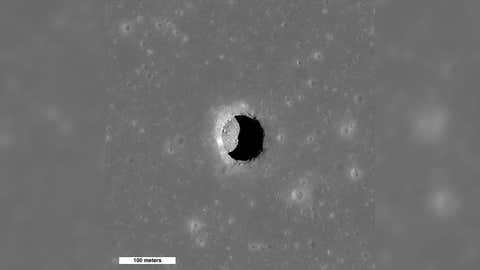
Scientists analyzing data from NASA’s Lunar Reconnaissance Orbiter (LRO) have discovered shaded locations inside craters on the Moon that always hover around a comfortable temperature of about 17 degrees Celsius, a temperature suitable for humans.
Craters and caves will form thermally stable sites for lunar exploration compared to regions on the moon’s surface, which reach a temperature of about 127 degrees Celsius during the day and cool to about -173 degrees Celsius at night.
Moon exploration is part of NASA’s goal to explore and understand the unknown in space, to inspire and benefit humanity.
Craters were first discovered on the moon in 2009, and since then, scientists have wondered if they led to caves that could be explored or used as shelters. It will also protect craters or caves from cosmic rays, solar radiation and micro-meteoroids.
“It’s likely that about 16 of the more than 200 craters are collapsing lava tubes,” said Tyler Horvath, a UCLA planetary science doctoral student who led the new research recently published in the journal. Geophysical Research Letters.
“Lunar craters are an amazing feature on the surface of the moon,” said LRO project scientist Noah Petro of NASA’s Goddard Space Flight Center in Greenbelt, Maryland. “Knowing that they create a stable thermal environment helps us paint a picture of these unique lunar features and the prospect of one day exploring them.”
Horvath processed data from the Diviner, a thermal camera, to see if the temperature inside the craters differed from that at the surface.
Focusing on a cylindrical depression roughly 100 meters deep that is the length and width of a football field in a region of the Moon known as Mare Tranquillitatis, Horvath and colleagues used computer modeling to analyze the thermal properties of rocks and moon dust and plot the crater temperatures over time.
The results revealed that temperatures within the crater’s permanently shaded stream fluctuate only slightly throughout the lunar day, remaining at around 17°C. If the cave extended from the bottom of the crater, as images taken by the Lunar Reconnaissance Orbiter Camera indicate, it would have had a relatively comfortable temperature.
The team believes that the drooping shade is responsible for the constant temperature, which limits the heat of things during the day and prevents heat from radiating away at night.
A day on the Moon lasts about 15 Earth days, during which time the surface is constantly bombarded with sunlight and is often hot enough to boil water. The very cold nights also last about 15 Earth days.
Launched on June 18, 2009, LRO has amassed a treasure trove of data using its seven powerful instruments, making an invaluable contribution to our knowledge of the Moon.
**
The above article was published from a news agency with minimal edits to the title and text.

“Beer aficionado. Gamer. Alcohol fanatic. Evil food trailblazer. Avid bacon maven.”
